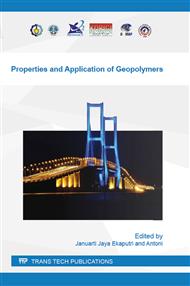[1]
Hui Cheng et al, 2015, Effect of solid-to-liquid ratios on the properties of waste catalyst–metakaolin based geopolymers, Construction and Building Materials 88(2015) 74-83.
DOI: 10.1016/j.conbuildmat.2015.01.005
Google Scholar
[2]
Davidovits J. 1989, Geopolymers and geopolymer new materials. Journal of Thermal Analysis; 35: 429–44.
Google Scholar
[3]
Duxson P et al. 2007, Geopolymer technology: the current state of the art. Journal of Material Science; 42: 2917–33.
Google Scholar
[4]
van Jaarsveld JGS, van Deventer JSJ, Lorenzen L. 1999, The potential use of geopolymer materials to immobilize toxic metals: Part 1. Theory and applications. Mineral Engineering; 10: 659–669.
DOI: 10.1016/s0892-6875(97)00046-0
Google Scholar
[5]
Komnitsas K, Zaharaki D. 2007, Geopolymerisation: a review and prospects for the minerals industry. Mineral Engineering; 20: 1261–77.
DOI: 10.1016/j.mineng.2007.07.011
Google Scholar
[6]
Cheng TW, Chiu JP. 2003, Fire-resistant geopolymer produced by granulated blast furnace slag. Mineral Engineering; 16: 205–10.
DOI: 10.1016/s0892-6875(03)00008-6
Google Scholar
[7]
Ahyudanari, E, et al (2014), Identification and modelling process of defining temperature gradient in airport pavement, Aviation, 18: 2, 72-79, DOI: 10. 3846/16487788. 2014. 926637.
DOI: 10.3846/16487788.2014.926637
Google Scholar
[8]
Elie Y. Hajj et al, (2010), Evaluation of the Use of Reclaimed Asphalt Pavement in Airfield HMA Pavements, Journal of Transportation Engineering, Vol. 136, No. 3, March 1, 2010. ©ASCE, ISSN 0733- 947X/2010/3-181–189.
DOI: 10.1061/(asce)te.1943-5436.0000090
Google Scholar
[9]
Kai Su et al (2009), Laboratory evaluation of WMA mixture for use in airport pavement rehabilitation, Construction and Building Materials 23 (2009) 2709-2714.
DOI: 10.1016/j.conbuildmat.2008.12.011
Google Scholar
[10]
Cooley Jr, L. Allen et al (2007), Improved porous friction course (PFC) on asphalt airfield pavement, Airfield Asphalt Pavement Technology Program (AATP) Project 04-06.
Google Scholar
[11]
Diegles Simoes de Toledo Pereira, Felipe Jose da Silva, Clelio Thaumaturgo. 2006. High Performance Fiber Reinforced Geopolymer Concrete For Pavement. Second International Airports Conference: Planning, Infrastructure & Environment.
Google Scholar
[12]
Davidovits, J. 1991. Geopolymer: Inorganic Polymeric New Materials. Geopolymer Institut.
Google Scholar
[13]
Muhammad Aiman bin Ismail. 2011. Creep Properties of Geopolymer Bituminous Mixtures. Universiti Teknologi Petronas.
Google Scholar
[14]
Li,Z., Ding,Z., Zhang,Y. 2004. Development Of Sustainable Cementitious Materials. Hongkong.
Google Scholar
[15]
Davidovits, J. (1999). Chemistry of Geopolymeric Systems, Terminology. Geopolymere '99 International Conference, Saint-Quentin, France, pp.9-22.
Google Scholar
[16]
Ekaputri, Koichi Maekawa, and Tetsuya Ishida. 2010. The Use of Geopolymerization Process for Boron Fixation in Fly Ash. Simposium Beton dan Semen Internasional.
Google Scholar
[17]
Davidovits, J. 2008. Geopolymer Chemistry and Applications. Geopolymer Institut.
Google Scholar
[18]
Xu, H. & Van Deventer, J.S.J. 2000. The geopolymerisation of alumino-silicate minerals", International Journal of Mineral Processing.
DOI: 10.1016/s0301-7516(99)00074-5
Google Scholar
[19]
Hardjito, D., Rangan, B.V. 2005. Development and Properties Of Low-Calcium Fly Ash- Based Geopolymer Concrete. Perth, Australia.
Google Scholar
[20]
Ekaputri, Triwulan and Damayanti. 2007. Mechanical Properties of Geopolymer Concrete with Jawa-Paiton Power Plant as Alternative Materials. Pondasi. Vol 13. ISSN 0853-814X (In Indonesian).
Google Scholar
[21]
Jenks, Christopher, et al (2011), A manual for design of hot mix asphalt with commentary, NCHRP Report 673, Transportation Research Board.
DOI: 10.17226/14615
Google Scholar
[22]
Badan Litbang Departemen Pekerjaan Umum. 1989. Pedoman Tentang "Pelaksanaan Lapis Campuran Beraspal Panas (SNI 03-1737-1989). Pustran Balitbang Pekerjaan Umum.
Google Scholar
[23]
ASTM International. ASTM C 39-94.
Google Scholar


